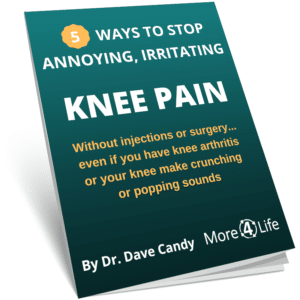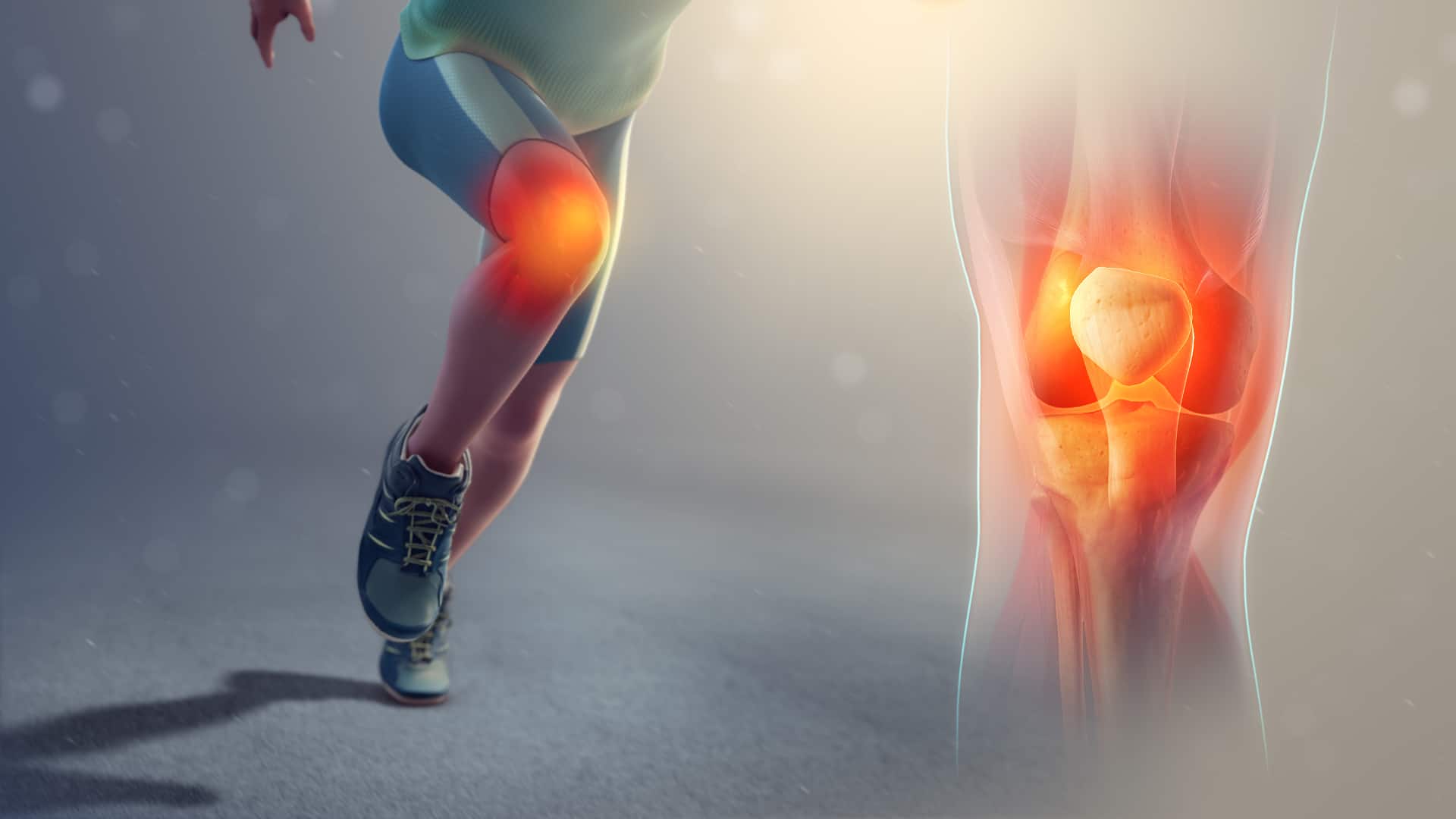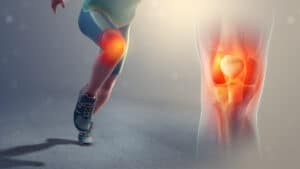In order to find the right treatment for patellofemoral pain syndrome, you first need to understand that patellofemoral pain syndrome is more than one thing. Therefore, there are many different types of treatment for patellofemoral pain syndrome.
In this post, you'll learn:
- What Is Patellofemoral Pain Syndrome?
- What Are The Symptoms Of Patellofemoral Pain Syndrome?
- What Causes Patellofemoral Pain Syndrome?
- What Is The Treatment For Patellofemoral Pain Syndrome?
- What Is Recovery Time For For Patellofemoral Pain Syndrome?
Note: This is an informational post. If you live in the St. Louis area, click here to learn about our treatment for knee pain or call our office at 314-941-3970.

What Is Patellofemoral Pain Syndrome?
Patellofemoral pain syndrome (PFPS) is one of the most common knee injuries, especially among athletes. It's characterized by pain in the front of the knee and around the patella (kneecap).
Patellofemoral pain syndrome is often aggravated by activities that put stress on the knee.
These may include daily activities such as:
Or exercises such as:
Symptoms Of Patellofemoral Pain Syndrome
The most common symptom of patellofemoral pain is knee pain. This pain is typically felt around the kneecap and may worsen the activities mentioned above.
Other symptoms of patellofemoral pain may include:
- crepitus
- stiffness
- locking
- instability
Crepitus
Crepitus is a creaking or grinding noise. This happens because the joint surfaces aren't aligned properly causing a grinding of the cartilage on the back of the knee cap. Crepitus is more common if the patellar cartilage has started to thin.
Knee Stiffness
People with patellofemoral pain syndrome also get stiffness when sitting for long periods with their knee bent. This is sometimes referred to as "movie-goer's" knee and can be a sign of chondromalacia patella.
Locking
Locking is typically as symptom that people associate with meniscus tears that structurally cause your knee to lock. However, with patellofemoral problems can sometimes cause so much pain that it prevents you from moving your knee. Sometimes this is referred to as "pseudo-locking" because the knee isn't structurally locked... it just hurts too much to move.
Knee Instability
Additionally, sometimes people who have dislocated their kneecap from an injury may have a knee that pops out of place. This can give a feeling of instability during activities such as going down stairs. In this case, it feels feels like your knee might give out. Wearing a patellofemoral knee brace is a helpful solution if you have an unstable knee cap.
What Causes Patellofemoral Pain Syndrome?
As mentioned before, there are many different kinds of patellofemoral pain, so there's more than one cause.
Medical diagnoses that can cause patellofemoral pain syndrome include:
- patellar tendonitis
- chondromalacia patella
- knee arthritis
- IT band syndrome (a.k.a. "runner's knee")
However more important than the medical diagnosis is finding the movement disorder that's caused the probmlem in the first place - the root cause so to speak.
In general, the root causes of patellofemoral pain generally fall into 1 of 4 categories.
4 Causes Of Patellofemoral Pain:
- Overuse/overload - This type of patellofemoral pain is caused by overtraining. Too much actitivity, too intense of activity, or not enough rest time between activities are the pain causes.
- Muscle performance deficits - When most people think about knee pain, they typically think of weakness in the muscles around the knee: the quadriceps and hamstrings. However, weakness in the hip muscles is the more common cause of patellofemoral pain because your hips help balance your body over your knee as well as keep you from overusing your quadriceps muscles.
- Movement coordination deficits - This type of patellofemoral pain has to do with controlling where the knee is in space. Usually the provoking movement is the knee going toward the midline of the body. This is sometimes referred to as a dynamic valgus. Weakness in the hips, stiff calves, and overpronation of the feet may be one case of patellofemoral pain.
- Mobility impairments - This cause of patellofemoral pain may include stiffness in the hip or ankle joints. It can also include a lack of flexibility inthe quadriceps, hamstrings, calves, or iliotibial band.
Treatment For Patellofemoral Pain Syndrome
There's no one-size-fits-all treatment for patellofemoral pain syndrome. The correct treatment option depends on the cause of the problem.
In most cases, it's not just one of the four causes mentioned above, but a combination of more than one. Identifying which of these causes are contributing to your patellofemoral pain is key to finding the right treatment.
Treatment For Overuse / Overload
If you're overtraining limit the number of miles you run or the amount of weight that you lift at the gym to only what you can do without flaring up your symptoms. Also, make sure that you're not still sore from your previous workout before starting the next workout.
For distance runners, don't increase your mileage more than 10% per week. If you lift weights, allow at least a day of rest between leg days.
Patellofemoral Pain Syndrome Exercises
If you have weakness in your hips, the following exercise may help:
If you have flexibility deficits, makes sure to stretch the muscles that are stiff:
Taping For Patellofemoral Pain
Taping your knee using Leukotape or Kinesiotape can be helpful to relieve knee pain.
Patellar Taping with Leukotape and Cover Roll
Taping your kneecap with Leukotape and Cover-Roll can help keep your knee aligned.
Patellar Taping with Kinesiology Tape
Taping your knee with kinesiology tape is another way to help keep your knee aligned.
Patellofemoral Pain Syndrome Braces
Patellofemoral knee braces do basically the same thing as taping except they're re-usable. If you have chronic patellofemoral instability, investing in a patellofemoral knee brace is a good idea.
The BraceAbility patellar knee brace is good for people with patellofemoral instability. The C-shaped pad in the picture helps hold the kneecap in the proper position.
(Note: While I really like this brace, the picture above from amazon actually shows the brace on upside down. The C-shaped pad should go on the outside of the knee.)
Physical Therapy For Patellofemoral Pain Syndrome
Finding the root cause of patellofemoral pain and fixing it can be a challenge. If you've been struggling with patellofemoral pain for more than a few weeks, it may be time to get physical therapy for it.
If you live in the St. Louis area and need physical therapy for your knee pain, we'd be happy to help.
Tap the button below to request an appointment with one of our specialists to learn how we can help.
What Is The Recovery Time For Patellofemoral Pain Syndrome?
The recovery time for patellofemoral pain syndrome can vary from weeks to years. In general, the faster you get started on treatment, the sooner you'll get better.
If you'd like to cut down your recovery time, click here to request a free phone consultation with one of our specialists.




